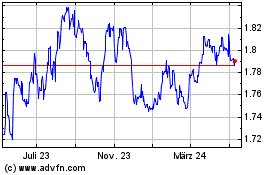NZ Dollar Drops Amid Risk Aversion
10 Dezember 2021 - 5:33AM
RTTF2
The NZ dollar weakened against its major counterparts in the
early European session on Friday, as the virus-led restrictions
across Europe and the spread of the Omicron coronavirus dented
investor sentiment.
The U.K. tightened rules to combat the spread of Omicron earlier
this week.
U.K. Prime Minister Boris Johnson imposed tougher COVID
restrictions in England, which includes requiring vaccine passports
for large events and an order to work from home.
Investors reacted to Fitch downgrade on real estate developers
China Evergrande and Kaisa Holdings to restricted default
rating.
The downgrade came after property developers defaulted on
interest payments on dollar bonds.
The latest survey from BusinessNZ showed that New Zealand
manufacturing sector continued to expand in November, albeit at a
much slower pace, with a manufacturing PMI score of 50.6.
That's down from 54.3 in October, although it remains above the
boom-or-bust line of 50 that separates expansion from
contraction.
The kiwi depreciated to a 2-day low of 0.6776 against the
greenback and near a 2-month low of 1.0548 against the aussie,
following its prior high of 0.6807 and a 2-day high of 1.0503,
respectively. The next possible support for the kiwi is seen around
0.66 against the greenback and 1.075 against the aussie.
The kiwi pulled back from its previous high of 1.6599 against
the euro, with the pair trading at 1.6654. On the downside, 1.68 is
possibly seen as its next support level.
The kiwi retreated to 76.99 against the yen, from a high of
77.30 seen at 10:30 pm ET. If the kiwi falls further, 75.00 is
possibly seen as its next support level.
Looking ahead, University of Michigan's preliminary consumer
sentiment index for December, inflation data and monthly budget
statement for November will be out in the New York session.
Euro vs NZD (FX:EURNZD)
Forex Chart
Von Mär 2024 bis Apr 2024

Euro vs NZD (FX:EURNZD)
Forex Chart
Von Apr 2023 bis Apr 2024
